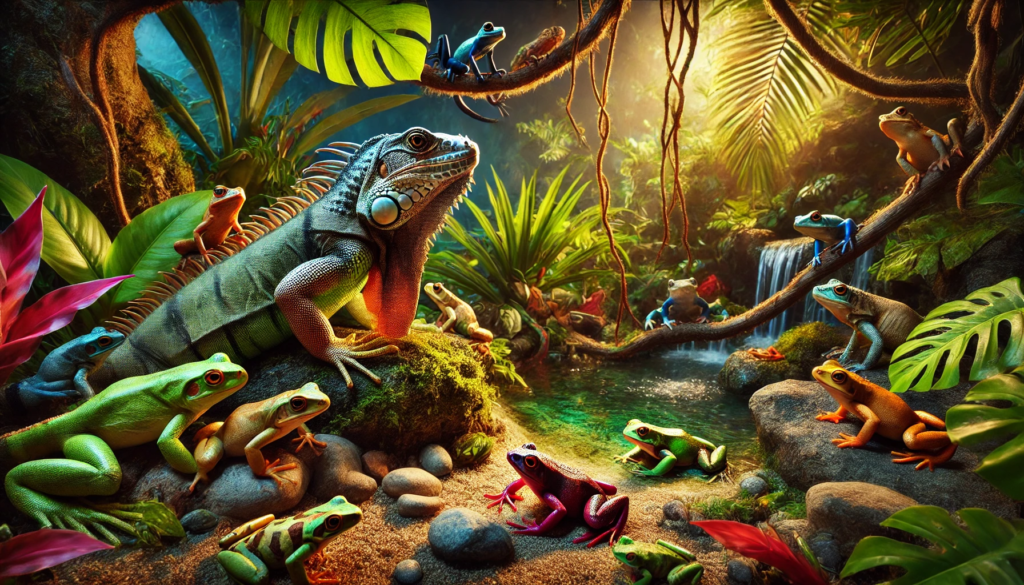The Caribbean, with its tropical climate and diverse ecosystems, is home to an extraordinary variety of reptiles and amphibians. From the vibrant frogs hidden in rainforests to the iconic iguanas basking in the sun, these species contribute significantly to the region’s rich biodiversity. Reptiles and amphibians in the Caribbean have adapted to a range of habitats, including rainforests, coastal mangroves, caves, and arid scrublands, making this region one of the most biologically unique in the world.
This article explores the diversity of reptiles and amphibians in the Caribbean, focusing on notable species such as iguanas, frogs, and snakes, while highlighting their ecological significance and the conservation challenges they face.
The Rich Diversity of Reptiles in the Caribbean
Reptiles have thrived in the Caribbean for millions of years, evolving in relative isolation on various islands. This isolation has led to the development of endemic species—species found nowhere else in the world. Caribbean reptiles include lizards, iguanas, geckos, snakes, and turtles, each adapted to the specific environmental conditions of their island habitats.
Iguanas: Giants of the Caribbean
Among the most iconic reptiles in the Caribbean are iguanas, which are large herbivorous lizards known for their impressive size and vibrant colors. Several species of iguanas are found throughout the Caribbean, many of which are endemic to specific islands.
Green Iguana (Iguana iguana)
The green iguana is one of the most recognizable reptiles in the Caribbean. Native to a wide range of islands, including Puerto Rico, the Dominican Republic, and the Lesser Antilles, the green iguana is a skilled climber and spends much of its time in trees. Despite its name, this iguana can range in color from bright green to darker shades of gray or brown, depending on its environment and age.
Green iguanas are primarily herbivorous, feeding on leaves, flowers, and fruits. They play an essential role in seed dispersal, helping to maintain the balance of plant life in their ecosystems. However, on some islands, they have become invasive, competing with native species and disrupting local ecosystems.
Lesser Antillean Iguana (Iguana delicatissima)
The Lesser Antillean iguana is endemic to the Lesser Antilles and is critically endangered due to habitat loss, hybridization with introduced species, and predation by invasive species. These iguanas are smaller and more delicate in appearance compared to their green cousins, with a unique blue-green coloration and pale faces.
Conservation efforts are underway to protect the Lesser Antillean iguana from further decline. Breeding programs, habitat restoration, and efforts to control invasive species are crucial to ensuring the survival of this iconic Caribbean reptile.
Lizards and Geckos: The Small But Mighty Reptiles
The Caribbean is home to a wide variety of lizards and geckos, many of which are endemic to specific islands or island groups. These reptiles are often small but play essential roles in controlling insect populations and maintaining the health of their ecosystems.
Anoles
Anoles are among the most abundant and diverse lizards in the Caribbean. These small, agile lizards are known for their ability to change color and their specialized toe pads, which allow them to climb vertical surfaces with ease. The Cuban brown anole (Anolis sagrei) and the Puerto Rican crested anole (Anolis cristatellus) are two examples of the many anole species found throughout the Caribbean.
Anoles are often found in forests, gardens, and even urban areas, where they feed on insects and small invertebrates. Their ability to thrive in various habitats makes them an essential part of the Caribbean’s ecosystem.
Geckos
Geckos are another widespread group of lizards found in the Caribbean. These nocturnal reptiles are known for their large eyes, sticky toe pads, and ability to make vocal sounds, unlike most other lizards. The Tropical house gecko (Hemidactylus mabouia) is a common species found in homes and buildings across the Caribbean, where it helps control insect populations by feeding on moths, mosquitoes, and other pests.
Snakes: Serpents of the Caribbean
While the Caribbean is home to fewer snake species compared to other tropical regions, several species are native to the islands, ranging from non-venomous colubrids to highly specialized blind snakes. Many of the region’s snake species are relatively small and pose no threat to humans, though they play vital roles in controlling rodent populations and maintaining ecological balance.
Cuban Boa (Chilabothrus angulifer)
The Cuban boa is the largest snake in the Caribbean, growing up to 15 feet in length. As an apex predator, the Cuban boa plays an essential role in controlling populations of rodents, birds, and small mammals. It is a non-venomous constrictor that subdues its prey by wrapping its powerful coils around it.
Despite its ecological importance, the Cuban boa faces threats from habitat destruction and persecution by humans. Many people mistakenly believe these snakes to be dangerous, leading to unnecessary killings. Conservation programs aim to educate the public about the importance of protecting these misunderstood reptiles.
Lesser Antillean Racer (Alsophis antiguae)
The Lesser Antillean racer is a small, non-venomous snake found on several islands in the Lesser Antilles, including Antigua and Barbuda. Once widespread, this snake’s population has declined sharply due to habitat destruction and predation by introduced species such as mongooses. Conservation efforts, including captive breeding programs and habitat restoration, are helping to protect the remaining populations of this endangered species.
Amphibians of the Caribbean: Frogs and More
Amphibians in the Caribbean are equally diverse, with frogs being the most well-known and widespread group. Many of these frogs have adapted to the islands’ tropical and subtropical environments, often displaying bright colors, distinctive calls, and specialized reproductive strategies. Several species of amphibians in the Caribbean are endemic, found only on specific islands.
Coquí Frogs: Voices of the Caribbean
One of the most iconic amphibians in the Caribbean is the coquí frog (Eleutherodactylus coqui), a small tree frog known for its distinctive “co-kee” call. Native to Puerto Rico, the coquí is a symbol of the island’s culture and biodiversity. With over 17 species of coquí frogs inhabiting the island, each has its own unique habitat and characteristics.
Puerto Rican Coquí
The Puerto Rican coquí (Eleutherodactylus coqui) is perhaps the most well-known species of coquí frog. It is active at night, where males call loudly to attract mates. Unlike many frogs, the coquí does not go through a tadpole stage. Instead, the eggs hatch into fully formed miniature frogs, which allows them to reproduce in areas without standing water.
Coquí frogs are vital to the Puerto Rican ecosystem, serving as both predator and prey. They feed on insects and small invertebrates, helping to control pest populations, while also serving as a food source for birds, snakes, and other predators.
Colorful Caribbean Frogs
Several species of frogs in the Caribbean are noted for their bright and vivid colors, which often serve as a warning to predators about their toxicity. These frogs are typically found in rainforests and other moist environments, where they thrive in the humid conditions.
Cuban Tree Frog (Osteopilus septentrionalis)
The Cuban tree frog is the largest tree frog in the Caribbean, growing up to 6 inches in length. Native to Cuba, the Bahamas, and the Cayman Islands, this species is known for its ability to adapt to a wide range of habitats, including urban areas. The Cuban tree frog’s skin secretes a mild toxin, which helps protect it from predators.
Hispaniolan Giant Tree Frog (Osteopilus vastus)
The Hispaniolan giant tree frog is another impressive amphibian, found only on the island of Hispaniola (shared by the Dominican Republic and Haiti). This frog is notable for its large size and powerful legs, which allow it to jump long distances. Like many amphibians, the Hispaniolan giant tree frog is vulnerable to habitat loss and environmental degradation, making conservation efforts critical for its survival.
Conservation of Caribbean Reptiles and Amphibians
The reptiles and amphibians of the Caribbean face numerous threats, including habitat destruction, invasive species, climate change, and human persecution. As island species, many reptiles and amphibians are especially vulnerable to these pressures, as they have limited ranges and specific habitat requirements.
Habitat Loss and Fragmentation
Urban development, agriculture, and deforestation are leading causes of habitat loss in the Caribbean. Coastal areas, forests, and wetlands—key habitats for many reptiles and amphibians—are being destroyed or fragmented, leaving species with fewer places to live, breed, and find food.
Invasive Species
Invasive species, such as the mongoose and feral cats, have had devastating impacts on native reptile and amphibian populations. These predators, introduced by humans, often prey on small reptiles and amphibians, driving some species to the brink of extinction.
Conservation Initiatives
Several conservation initiatives are underway to protect the reptiles and amphibians of the Caribbean. These efforts include habitat restoration, the creation of protected areas, captive breeding programs, and public education campaigns aimed at reducing the negative impacts of human activity on these species. Organizations such as the Caribbean Amphibian and Reptile Conservation Program (CARCP) work closely with local governments and communities to develop strategies for preserving biodiversity in the region.
Conclusion
The Caribbean is home to an incredible array of reptiles and amphibians, each adapted to the unique environments of the islands. From the towering iguanas of the Lesser Antilles to the vibrant coquí frogs of Puerto Rico, these species play critical roles in maintaining the ecological balance of their habitats. However, they face significant threats from habitat loss, invasive species, and climate change, making conservation efforts more important than ever.
By promoting the conservation of these species and their habitats, we can help ensure that future generations continue to enjoy the beauty and biodiversity of the Caribbean’s reptiles and amphibians.
FAQ
What are the most common reptiles in the Caribbean?
The Caribbean is home to various reptiles, including iguanas, anoles, geckos, and snakes. Notable species include the green iguana, Cuban boa, and Lesser Antillean iguana.
Are there any dangerous snakes in the Caribbean?
Most snakes in the Caribbean are non-venomous and pose no threat to humans. The Cuban boa, for example, is a large but non-venomous constrictor. However, caution should always be taken around wildlife.
What is the coquí frog, and why is it important?
The coquí frog is a small tree frog native to Puerto Rico, known for its loud, distinctive call. It plays a vital role in controlling insect populations and is a cultural symbol of Puerto Rico.
Why are some Caribbean reptiles and amphibians endangered?
Habitat destruction, invasive species, climate change, and human activity are the primary threats to Caribbean reptiles and amphibians. Many species are endangered due to the loss of their natural habitats and predation by introduced animals.
How can we protect Caribbean reptiles and amphibians?
Conservation efforts, including habitat restoration, the creation of protected areas, and public education, are key to protecting the reptiles and amphibians of the Caribbean. Supporting local conservation initiatives is critical for preserving these species.
Are iguanas native to all Caribbean islands?
Not all Caribbean islands have native iguanas, but several species are found across the region, with some being endemic to specific islands. The green iguana, for instance, is widespread, while species like the Lesser Antillean iguana are restricted to certain islands.

